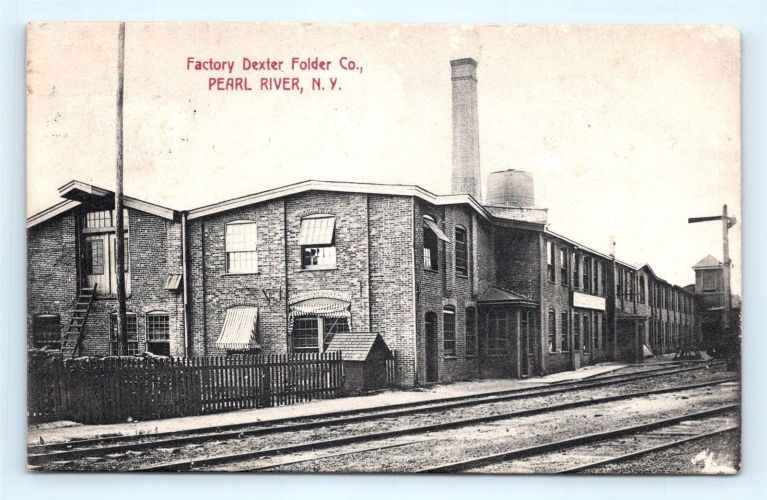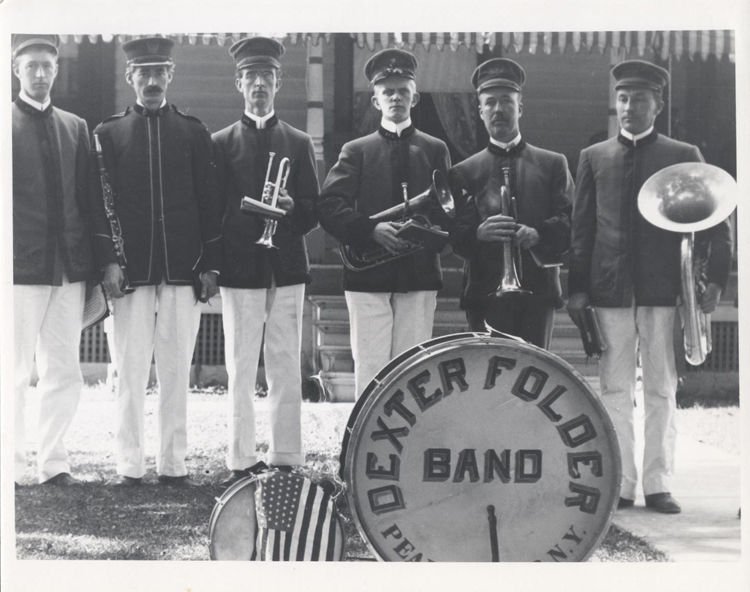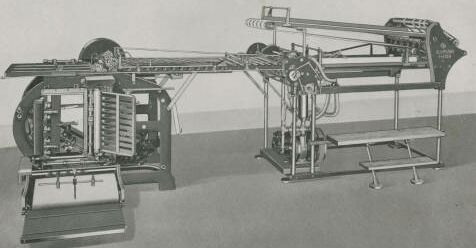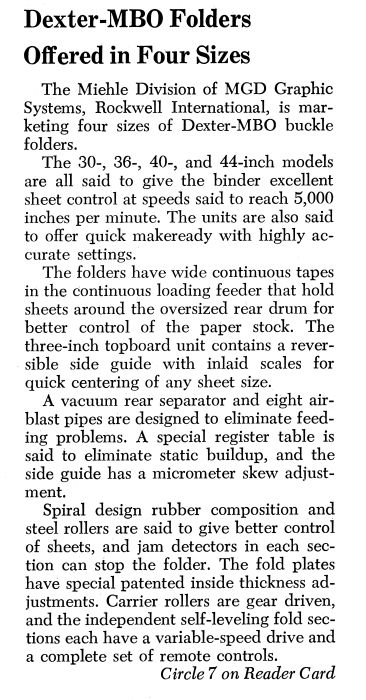

|
Today the old Cleveland folders are a rarity that only us oldtimers remember. MBOs and Stahls are the folders of today. If you remember taping the rollers, walking up a step to load the board, curling the front sheet edges to avoid dogears, cleaning oil from time to time off the "space wheel," setting the dog pawl to where the load should feed up to, and pulling a bar back to stop the feeder instead of pushing a electrical button... then you probably ran Cleveland or old Baum folders! Also the early folders were multisectional and you switched from a "cross carrier" to a take out belt and tray after the last section to be used. Various types of folders are- pile folders, friction feed, and continous feed. Then there is roller buckle folders and knife folders. And now there are regular stackers and various barrel etc... stackers. This page isn't a lesson on what folders are or do, its for those who have worked in the field, so onward we go to learn about Dexter Cleveland folders! |
 Dog pawl ratcheting feeders with counterweight bar (not seen) for sheet weight were long since replaced by electrical finger feeders. |
Talbot Chambers Dexter founded the Dexter Folder Company in 1880 in Pearl River, New York. The company might not have incorporated until 1894 as the Dexter firm. It originally had about 50 employees, but after World War Two started the company grew to over 300.

|
 Early company photo shows the first type of folder, as seen in left illustration. It was a hand fed knife folder. |
 This is a 1904 Dexter folder machine. |
The Dexter Folder Company did not stop there in its many feed tables for presses and folder advancements beyond the above one knife fold folder, but we are going to go on now to...

|
 At left is a 1917 Cleveland Folding Machine Co. folder ad. The above 1926 Cleveland Folding Machine Co. book makes no mention of the N.Y. Dexter Folder Co. This knowledge shoots down a theory I bet you never thought of as to why the Dexter Folder Company called their folders Cleveland. I know the first rational thought is the factory was in Cleveland. Yes, but also Grover Cleveland was a two term President and former Mayor of Buffalo, N.Y. around the time of the beginning of Dexter's Pearl River, N.Y. company. |

The Cleveland Folding Company was bought by the Dexter Folder Company in 1930, probably a result of the Depression. A Google books search of multiple "snippet views" reads-
Printers' ink, Volume 153, Decker Communications, inc., 1930
PV Jones Leaves Cleveland Folding Machine. Paul V. Jones, after twelve years as manager of sales, service and advertising of The Cleveland Folding Machine Company, Cleveland, has resigned. The company recently was acquired by the Dexter Folder Company, at which time Mr. Jones was elected secretary and, later, made works manager of the Cleveland plant. His resignation follows within a few weeks of the death of his father, Mr. E. H. Jones, former President and General Manager of the Cleveland Folding Machine Company and organizer of it twenty-two years ago...
Another Google books search "snippet view" reads-
The publishers weekly: Volume 187, R.R. Bowker Company, Publishers' Board of Trade (U.S.), Book Trade Association of Philadelphia - 1969
He joined the Cleveland Folding Machine Company in 1924 and then became part of the Dexter organization in 1930 when Cleveland was absorbed by Dexter. He was elected a Dexter vice-president in 1940, a director in 1953, and when Dexter...


The company had some main models but never stopped making different folders.


MS folders were a mid sized signature folding machine. The CU was about the same size but "Unitized." (Cleveland Unitized) There were smaller sized folders and larger. The K series such as KS was the largest. I always thought "MS" stood for multi-section but maybe it meant mid sized and maybe "KS" was king sized.?? I have no idea really of most of the initials.
To see more about the Dexter Cleveland time period of folder models refer to this web page-
Dexter Cleveland folder models


The smaller folders, such as the AS above, had a fast and slow gear which you could slide either to the running gear, depending on the speed you desired. Also the fold down additional rubber tires were helpful for smaller brochures. The folder in this photo doesn't have them.


|

|
|
The Goss Printing Press Company, Miehle Printing Press and Manufacturing Company, and Dexter Folder Company merged in 1957 to form Miehle-Goss-Dexter. The Dexter Folder Company still made Cleveland folders, as a division of Miehle-Goss-Dexter. Miehle-Goss-Dexter became the world's largest manufacturer of printing presses and graphic arts equipment. It was a Fortune 500 company in the 1960s, number 461. The combined company was acquired by North American Rockwell in 1969, and Miehle-Goss-Dexter was reborn as MGD Graphic Systems of North American Rockwell. North American Aviation had merged with Rockwell-Standard (owner of Aero Commander) in 1967 to become North American Rockwell. In 1973 North American Rockwell became Rockwell International. The company consisted of eight former companies; Collins Radio Co.; Dexter Folder Co.; Goss Printing Press Co.; Miehle Printing Press and Manufacturing Co.; North American Aviation Inc.; Reliance Electric and Engineering Co.; Standard Steel Spring Co.; and Timken-Detroit Axle Co.
From a 1975 the Inland Printer magazine- From the above information, now you can aproximately date these manuals, above, and at right. Dexter's folders under MGD when owned by North American Rockwell dropped the "Cleveland" brand name. |

|
In the above first statement the term "merged" was used. This sounds like a partnership. It was until all Dexter's stock was bought. Then they could no longer call the shots. They were owned and could be moved or sold. The Dexter Folder Co., Inc., ceased to exist in 1956. For the time being the factory in Pearl River, NY had plenty of work and maybe more so from the merger but they were now set up for the whims of those who cared more about their own aims and not the former company's fate.
Below is from a 1970 court case, Hargraves v. Brackett Stripping Machine Co., and is a statement by Miehle-Goss-Dexter, Inc.-
As regards the Dexter Folder Co., Inc., it appears that this corporation was founded in Des Moines, Iowa, in 1890 and moved to Pearl River, New York, in 1894. In 1927 the Miehle Printing Press and Manufacturing Company acquired a 50% interest in the Dexter Folder Co., Inc., and in February 1956 acquired the remaining 50% interest. In September 1956 Dexter Folder Co., Inc., was merged into Miehle Printing Press and Manufacturing Company. Thereafter the name of the corporation was changed to Miehle-Goss-Dexter, Inc., and the former Dexter Folder Co., Inc., is now operated as a division of Miehle-Goss-Dexter, Inc.
Federal supplement. [First Series.] - Volume 317 - Page 678
1971
disputed from the interrogatories in this case that while Dexter Folder Co., Inc., and Miehle-Goss-Dexter, Inc., were separate and distinct corporations at one time, Miehle-Goss-Dexter, Inc., acquired all of the stock of Dexter Folder Co., Inc., and ...
 During the last years of Dexter Folders, the folders were made in Canada. They were painted blue instead of the old gray-green. |
 |

There are still some early 1970s Dexter-MBO folders floating around out there which bear witness to something between MBO and Dexter folders.


 From the Inland Printer, April 1973, page 67 |
From the Inland Printer, American Lithographer, Volume 176, 1975-
Page 13 The sale of manufacturing facility to Dexter - Lawson Products Ltd., a newly- formed Canadian firm, by Graphic Systems Group (GSG) of Rockwell international of Canada Ltd. has been jointly announced by both firms. The sale includes an 86,000 square-foot fully equipped plant located in Cambridge, Ontario, Canada. It also includes the manufacturing and marketing rights for paper cutters, mill trimmers, paper drilling machines, buckle folders and metal handling machines sold under the trade name Dexter and Lawson. However, Edward Lemanski, GSG's vice president-Miehle Commercial Products said that GSG would retain the marketing and service of Wohlenberg (Cutters) and MBO (Folders) product lines to the graphic arts industry. Page 34 MBO is the way to go, says folder manufacturer Miehle's Pete Trittipo (L) and MBO chief executive officer Heinz Binder inspect new MBO T-74 Buckle Folder at DRUPA show. |


In 1965 Heinz Binder started the MBO company as a parts production factory for the aviation industry. By the late sixties his Oppenweiler, West Germany plant was instead producing MBO folder machines for the graphic arts industry.
The translation is- Machine Builder of Oppenweiler Binder GmbH & Co. (GmbH is a legal entity in German law)
Or for short, the company's U.S. name is-
Machine Builder of Oppenweiler or...
MBO
About this time the engineers changed many of the mechanical workings into electronics. Many improvements have happened to folders since the days of the Dexter Folder Company, but it echoes back to when the United States was the world's leader and industrial giant bar-none.
I have witnessed jobs folded on old Clevelands that most MBO folder operators couldn't do on an MBO. They were nice machines.
This page is the result of webpage searches and some pics off the web, and brochures and manuals and photos that I own. All information is correct to the best of my knowledge.
-Dennis Weaver